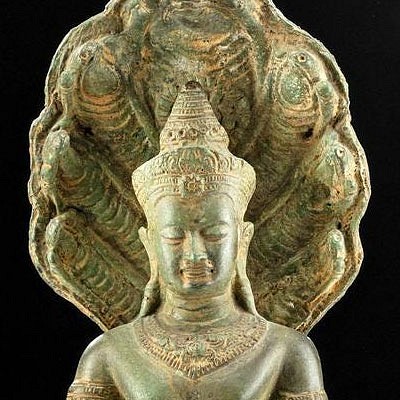Chavin Pottery Bridge Vessel w/ TL, ex-Museum
Lot 122
About Seller
Artemis Gallery
686 S Taylor Ave, Ste 106
Louisville, CO 80027
United States
Selling antiquities, ancient and ethnographic art online since 1993, Artemis Gallery specializes in Classical Antiquities (Egyptian, Greek, Roman, Near Eastern), Asian, Pre-Columbian, African / Tribal / Oceanographic art. Our extensive inventory includes pottery, stone, metal, wood, glass and textil...Read more
Categories
Estimate:
$1,000 - $1,500
Absentee vs Live bid
Two ways to bid:
- Leave a max absentee bid and the platform will bid on your behalf up to your maximum bid during the live auction.
- Bid live during the auction and your bids will be submitted real-time to the auctioneer.
Bid Increments
| Price | Bid Increment |
|---|---|
| $0 | $25 |
| $300 | $50 |
| $1,000 | $100 |
| $2,000 | $250 |
| $5,000 | $500 |
| $10,000 | $1,000 |
| $20,000 | $2,500 |
| $50,000 | $5,000 |
| $100,000 | $10,000 |
| $200,000 | $20,000 |
About Auction
By Artemis Gallery
Aug 10, 2021
Set Reminder
2021-08-10 12:00:00
2021-08-10 12:00:00
America/New_York
Bidsquare
Bidsquare : Museum-Deaccession | Asian & Pre-Columbian
https://www.bidsquare.com/auctions/artemis-gallery/museum-deaccession-asian-pre-columbian-7316
An interesting mix of de-accessioned Asian and Pre-Columbian Art from The Ashland University Museum in Ashland, OH, originally donated between 1994 to 1998. All lots from the Museum have been noted, as such. Artemis Gallery info@artemisgallery.com
An interesting mix of de-accessioned Asian and Pre-Columbian Art from The Ashland University Museum in Ashland, OH, originally donated between 1994 to 1998. All lots from the Museum have been noted, as such. Artemis Gallery info@artemisgallery.com
- Lot Description
Pre-Columbian, North Coast Peru, late Chavin, ca. 600 to 400 BCE. A wonderful hand-built blackware bridge vessel presenting a two-tiered shape that incorporates zoomorphic and architectural elements into the form. The lower body rests on a flat base, with a compressed globular shape that is incised with a register of spiraling motifs. The top resembles a house known as a chosa, with a sloping panel that creates a roof. A narrow spout rises at an angle from one side with a handle that spans across to an owl finial. The owl is delightfully detailed with incised lines, applied eyes, and a pinched beak. Owls are prominent in Andean art since Peru is home to over 30 different species, and their unusual nighttime activities were the source of legends. Shamans were believed to take the form of owls, and owls carried deceased warriors to the underworld. This is a remarkable vessel with striking symbolism! Size: 5" Diameter x 6.5" H (12.7 cm x 16.5 cm)
This piece has been tested using thermoluminescence (TL) analysis and has been found to be ancient and of the period stated. A full report will accompany purchase.
Provenance: ex-Ashland University Museum, Ashland, Ohio, USA, donated to Ashland University between July 1994 to December 1998
All items legal to buy/sell under U.S. Statute covering cultural patrimony Code 2600, CHAPTER 14, and are guaranteed to be as described or your money back.
A Certificate of Authenticity will accompany all winning bids.
PLEASE NOTE: Due to recent increases of shipments being seized by Australian & German customs (even for items with pre-UNESCO provenance), we will no longer ship most antiquities and ancient Chinese art to Australia & Germany. For categories of items that are acceptable to ship to Australia or Germany, please contact us directly or work with your local customs brokerage firm.
Display stands not described as included/custom in the item description are for photography purposes only and will not be included with the item upon shipping.
#166055TL hole on the base and second TL hole on the underside edge of roof. Chips and losses to spout rim. Surface abrasions and pitting around shoulders. Small cavity before owl finial. Fine details and burnishing marks.Condition
- Shipping Info
-
All shipping is handled in-house for your convenience. Your invoice from Artemis Gallery will include shipping calculation instructions. If in doubt, please inquire BEFORE bidding for estimated shipping costs for individual items.
-
- Buyer's Premium



 EUR
EUR CAD
CAD AUD
AUD GBP
GBP MXN
MXN HKD
HKD CNY
CNY MYR
MYR SEK
SEK SGD
SGD CHF
CHF THB
THB














